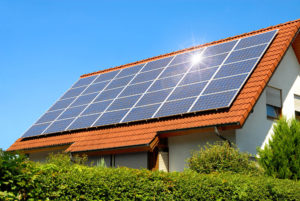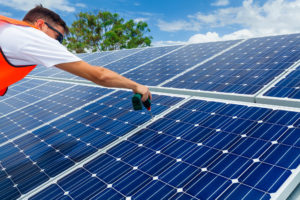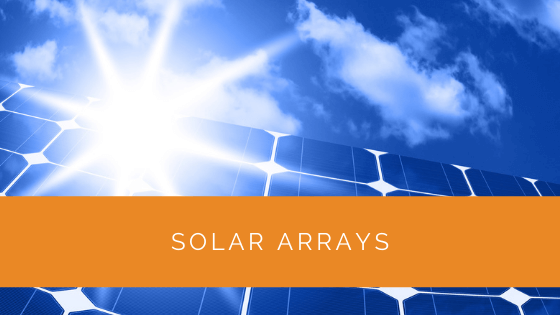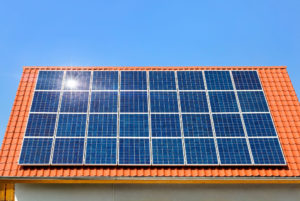Are you curious about the world of solar power? Are you looking for a comprehensive guide that can help you understand its basics, types, and environmental benefits? Look no further! Our informative guide is here to provide you with clear and accessible insights into the world of solar panels and arrays.
Not only will we cover the fundamentals of solar arrays, we’ll also delve into the types of panels available in the market, their costs and efficiency, and how they can help you reduce your carbon footprint. Furthermore, we’ll explore government incentives that can help you save money on installation costs, space requirements that you need to keep in mind before installing a solar panel, and maintenance tips to ensure your solar panel lasts for years. By the end of our guide, you’ll have a deep understanding of how solar power works, how it can help you save money on your energy bills, and how it can contribute to a sustainable future. So why wait? Join us in exploring the potential of solar power today!
Contents
- 1 Key Takeaways
- 2 What Is a Solar Array?
- 3 Orientation and Location of Your Array
- 4 Types of Solar Panels
- 5 Initial Cost and ROI
- 6 Feed-in-Tariff and Smart Export Guarantee
- 7 How Much Space Do They Need?
- 8 Can the Array Be Modified in the Future?
- 9 Benefits of Using Solar Panels
- 10 Disadvantages of Solar Panels
- 11 The Lifespan of Solar Panels
- 12 How to Maintain Solar Panels
- 13 Case Study: Optimising Solar Array Installation for a Sustainable Home
- 14 Expert Insights From Our Solar Panel Installers About Solar Arrays
- 15 Discover the Power of Solar with Solar Panels Network
- 16 Final Words
Key Takeaways
- Solar energy accounts for 4% of the UK’s total electricity generation, making it a viable renewable energy source despite the country’s climate.
- South-facing solar panels are most efficient in the UK due to its northern hemisphere location, but ground-mounted systems can be even more productive.
- Solar panel options include monocrystalline, polycrystalline, and solar-powered roof tiles, each with advantages and costs. The initial investment in a solar system can lead to long-term savings through energy generation and government incentives.
What Is a Solar Array?
When it comes to solar panel systems, the solar array is the most crucial component. It houses all of your system’s solar panels, which gather sunlight and turn it into energy.
A solar array comprises several solar panels that work together to produce energy.
Direct current (DC) energy is generated when sunlight strikes an array of solar panels. DC energy generated by the array is converted to usable alternating current (AC) electricity via an inverter system.
Large-scale solar farms are commonly referred to as solar arrays, although the word may apply to any collection of solar panels.
Orientation and Location of Your Array
The UK lies in the Northern Hemisphere. This implies that the Sun is above the equator, making south-facing solar panels most efficient.
If solar panels face south, you’ll have direct exposure to the Sun all day. This gives them the most time possible to gather sunlight and turn it into energy.
However, rooftops aren’t your only option for installing solar panels. A ground-mount solar system may be a better option if you have a lot of property and access to plenty of sunlight. An array on the ground may generate more energy over time since the roof’s size does not limit it and can be faced and angled ideally for optimum output.

Types of Solar Panels
Your needs will determine the kind of solar PV panel you select, your accessible space, and the amount of money you spend. Since their inception, solar cells have made significant progress. Their technological advancements have elevated them to new levels of efficiency while also improving their visual appeal.
- Monocrystalline solar panels: These are smaller and lighter than panels made of polycrystalline silicon. But they produce approximately the same amount of electricity. However, they may be more costly.
- Polycrystalline solar panels: Their manufacturing process is easier, making it less expensive but less efficient at high temperatures. This isn’t a big deal if they’re only used for your house. The downside is that you’ll need more room for them since you’ll have more in number.
- Solar-powered roof tiles: These tiles seem like regular ones but include a built-in battery. For those who are concerned about the aesthetics of solar panels, they may be a better choice. These are expensive and cost about £10,000 for a typical three-person house.
Initial Cost and ROI
The cost of solar systems in the UK starts at about £4000 £6000 for the initial installation. The more accessible roof space you have, the more energy your photovoltaic system will produce.
In the first year, a 4kw system on a 21 metre sq. roof might earn you £700 in savings, and after 20 years, it could bring in £6,750 in savings. After recovering the first investment, you’ll start earning and saving money.
Feed-in-Tariff and Smart Export Guarantee
The Feed-in Tariff is a government programme that rewards people and companies using solar PV panels to generate energy. Incentives for eligible PV owners include two payments over twenty years.
- Generation Tariff: Payments per kilowatt-hour (kWh) produced by your solar PV panels
- Export Tariff: Payment for energy produced by your system but unused is automatically transferred to the national grid tracked by export.
Feed-in tariffs have ended, but part of the solar energy produced will undoubtedly be returned to the grid. And because it is unlawful not to be compensated for this under existing laws, a new mechanism has been developed.
A new effort in a Smart Export Guarantee will compensate solar power producers for energy exported to the grid.
How Much Space Do They Need?
If you want to use solar PV, you’ll need at least 10 square metres of clear roof area, about the size of a regular vehicle parking spot. This won’t be a problem in most houses, but ensure it doesn’t block vents.
Can the Array Be Modified in the Future?
If your electricity consumption is expected to rise in future, you might consider adding more solar panels to your array. Expanding your system in the future is feasible if you have enough room for extra panels.
However, there are a few considerations to bear in mind.
- If space is an issue, you may want to spend more on high-efficiency equipment (monocrystalline panels) while building your initial array. This optimises your total energy output while preserving room for future panels,
- Find out whether your installer has worked on any such projects. To avoid problems, it’s generally simpler to deal with the company that performed the initial installation.
- If you know your energy consumption will rise shortly, it’s a good idea to oversize the system to prevent a costly add-on project. You’ll save money on labour and permits if you do this.

Benefits of Using Solar Panels
There are many advantages of using solar power to generate electricity.
1. Environment-Friendly
Using solar panels to power your house or company reduces your carbon footprint since no pollutants are generated while they are operating.
2. Save Money
Whatever energy you generate is completely free and may be used to power anything in your house for free. This will result in reduced energy costs and longer-term savings of money.
Since the feed-in tariff is repealed, you’ll see an increase in the return on your investment thanks to the Smart Export Guarantee that has taken its place.
3. Renewable Sources of Energy
Energy from the Sun will never run out, and solar panels operate even on gloomy days, so you should have enough free power throughout the year.
You may store the energy you generate and utilise it at night by installing a battery storage device. As an added benefit, it reduces your carbon impact.
Disadvantages of Solar Panels
With all the fantastic benefits, solar panels also come with a few cons.
1. No Solar Power at Night
Some individuals considering going solar may question whether they can entirely cut themselves off the grid after making the switch. This isn’t feasible.
Solar-powered homes must depend on utility grids or battery storage at night to keep their lights on.
2. Questionable Reliability and Efficiency
Solar panels in the UK are limited in how much electricity they can produce due to the lack of a very sunny climate.
Solar panels may still generate electricity even on cloudy or rainy days, but their efficiency plummets. Therefore, backup power sources are required at night. Because electricity production soars in the summer and drops in the winter, we have an uncertain energy supply all year round.
The Lifespan of Solar Panels
Solar panels are becoming an increasingly popular choice for supplying electricity to UK households. The newest solar panel types on the market are anticipated to last 40-50 years, with warranties covering at least half of that lifetime.
You may expect your solar panels to last for over 40 years if you take excellent care of and maintain them. However, their performance levels will have decreased somewhat during that time. Both monocrystalline and polycrystalline solar panels have a life expectancy of around 50 years.

How to Maintain Solar Panels
Solar panels are constructed to withstand severe and unpredictable weather conditions for extended periods. This is why solar panels are long-lasting and need little to no maintenance.
For the most part, keeping your solar panels clean and in excellent condition should last for many years.
Regularly checking the panel output through the inverter or your monitoring system is also critical. In other words, if the production is lower than anticipated, you will know why and be able to get your panels back up and running as efficiently as possible.
Case Study: Optimising Solar Array Installation for a Sustainable Home
Background
Our client, a family in rural England, sought a sustainable solution to reduce their carbon footprint and lower their energy bills. With ample space available, they were keen to explore the benefits of a solar array. The primary objective was to design a system that maximized energy production while fitting seamlessly with the property’s aesthetic and functional needs.
Project Overview
We assessed the client’s property, which included a spacious, sun-exposed field ideal for a ground-mounted solar array. The family was interested in a system that could cover their entire electricity consumption and potentially generate surplus energy for future electric vehicle charging needs. They also wanted to ensure the system was scalable and adaptable to any future expansions.
Implementation
- System Design: We designed a ground-mounted solar array featuring high-efficiency monocrystalline panels. This choice was driven by the need for maximum energy output and the client’s preference for fewer, more efficient panels.
- Installation: The array was installed at an optimal tilt and orientation to ensure maximum sunlight exposure throughout the year. The ground-mounted system provided flexibility in panel placement, allowing for easy maintenance and potential future expansion.
- Inverter and Monitoring: We installed a state-of-the-art inverter system capable of converting DC to AC efficiently and included a comprehensive monitoring system. This setup allows the family to track energy production and consumption in real time, ensuring they maximize their system’s benefits.
- Energy Storage: To enhance energy independence, we incorporated a battery storage system. This solution stores excess energy generated during the day, which can be used during peak hours or nighttime, reducing reliance on the grid.
Results
- Energy Independence: The installed system now covers 100% of the family’s electricity needs, including heating and cooling. The energy storage system provides an additional layer of security and efficiency.
- Cost Savings: The client has seen a substantial reduction in their energy bills, with the system expected to pay for itself within the next 7-8 years. The inclusion of battery storage further enhances savings by allowing the use of stored energy during peak tariff times.
- Environmental Impact: The family has significantly reduced their carbon footprint, with the solar array contributing to a cleaner, renewable energy source. This aligns with their commitment to sustainability and environmental responsibility.
- Future-Proofing: The system’s design allows for easy expansion, accommodating potential future increases in energy demand, such as the addition of electric vehicle charging stations.
Summary
This project exemplifies the successful implementation of a solar array in a rural residential setting. By choosing the right technology and installation method, we were able to meet the client’s energy needs while providing significant cost savings and environmental benefits. At Solar Panels Network, we continue to lead in providing tailored solar solutions that align with our clients’ sustainability goals and energy needs. This case study highlights our expertise in optimizing solar installations for long-term success and client satisfaction.
Expert Insights From Our Solar Panel Installers About Solar Arrays
Solar arrays are a cornerstone of solar power systems, providing the essential infrastructure for converting sunlight into usable energy. The choice of panel type and installation method can significantly impact the system’s efficiency and overall energy yield. For residential projects, we often recommend ground-mounted systems for their flexibility and potential for optimal positioning.
Senior Solar Installer
Understanding the various types of solar panels, such as monocrystalline, polycrystalline, and solar-powered roof tiles, is crucial for homeowners. Each type has unique benefits and costs, and choosing the right one can lead to substantial long-term savings and environmental benefits. It’s all about balancing initial costs with efficiency and aesthetic considerations.
Renewable Energy Consultant
Maintenance and durability are key factors in ensuring the longevity of a solar array. Regular inspections and cleaning, along with proper installation, can help solar panels last for decades, delivering consistent energy savings. Investing in quality panels and professional installation pays off in the long run.
Lead Solar Technician
Discover the Power of Solar with Solar Panels Network
Are you navigating the world of solar installations? Look no further than Solar Panels Network, the UK’s trusted partner in harnessing the Sun’s potential. Our dedication goes beyond just installations; we’re on a mission to transform how homeowners and businesses across the UK perceive and utilise energy. By choosing us, you’re reducing your carbon footprint and making a smart financial move that promises savings for years ahead. Contact us today and embark on your solar journey.
Final Words
A PV solar system may seem like an enormous project, but it is essential to remember that it is an investment in the long run. Solar energy is a cost-effective option in many countries, including the UK.
Clean, renewable energy also has environmental advantages that help decrease carbon emissions and our total contribution to climate change.
Anything that helps households save money while saving the planet for future generations is worthwhile in terms of research and investment.
About the Author
Solar Panels Network stands at the forefront of solar energy solutions, driven by a team of seasoned solar engineers and energy consultants. With over decades of experience in delivering high-quality solar installations and maintenance, we are committed to promoting sustainable energy through customer-centric, tailored solutions. Our articles reflect this commitment, crafted collaboratively by experts to provide accurate, up-to-date insights into solar technology, ensuring our readers are well-informed and empowered in their solar energy decisions.


